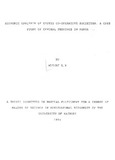Economic analysis of coffee co-operative societies. A case study of Central Province in Kenya
Abstract
The coffee industry is an important sub-sector in
agriculture. However, despite its importance, the industry
has been facing a lot of problems especially in the marketing
of coffee by the co-operatives. The co-operativ~ sub-sector
of the coffee industry has been blamed for inefficiencies in
internal coffee marketing. Neither have the various aspects
of this inefficiency been identified nor ar~ factors
underlying it clear. This study focused on analysing the
factors that affect the efficiency of coffee marketing by the
co-operative societies. The objectives of this study were:
1. To describe the cost structure of coffee cooperative
societies in the area of study and
establish the optimal level of operation.
2. To establish whether the costs recovered by the
societies are economically justified.
3. To determine factors responsible for costs variation
and whether there is scope for improving
efficiency of t.hecoffee co-operative societies and
the factories.
To achieve the first objective, regression analysis was
used while correlation analysis was used to assess whether
the marketing costs were significantly different from the
marketing margins. The study also evaluated whether the
societies were efficient in handling of farmers' payment by
analysing the ratio of clean coffee to cherry coffee. To
evaluate whether there is scope for improving efficiency
through improvement of technical efficiency, the study used
-viiidescriptive
analysis of accounting data. In this approach,
the factories were categorized into four groups according to
size. The groups were then analysed whether they differed in
their ability to keep unit cost down or whether the
differences in levels of various cost items were due to
chance fluctuations.
Two hypotheses based on the objectives were advanced. It
was hypothesized that, the co-operative societies do not
operate at minimum cost and that the deductions (marketing
margins) made by the co-operative societies are not
significantly different from the marketing costs.
To achieve the above objectives, relevant data were
collected and analysed using statistical Package for Social
Sciences (SPSS). The data were collected from sampled
societies in central province, Kenya Planters Co-operative
union (KPCU) and Ministry of Co-operative Development (MOCD).
The study found out that:
1. Most co-operative societies operate at levels lower
than the optimum and consequently incur very high
costs. The optimum level of cherry intake was found
to be about 7.5 thousand tonnes at a cost of Kshs
751.73 per tonne of cherry processed. The societies
have therefore not managed to reduce per unit
marketing cost as they are meant to do.
2. The co-operative societies make higher deductions
than can be justified by the estimated marketing
costs. The mean marketing margin was Kshs 1.85
which was significantly higher than the mean
-ixmarketing
cost which was Kshs 1.21 per kilogram of
cherry processed.
3. The co-operative societies are inefficient in the
handling of the farmers' paYments as shown by the
analysis of cherry: clean coffee ratio. The ratio
as calculated in this study (6.74) was
significantly less than that recorded by the
societies (6.79). This showed that farmers were
losing about 0.05 Kilograms of cherry per every
tonne of clean coffee.
4. There is scope for improving the efficiency of cooperative
societies through improvement of
technical efficiency by expansion of volume of
cherry handled.
It is concluded that the overall performance of the cooperative
societies is unsatisfactory and that there is need
to make improvements in area of providing marketing services
so that marketing margins are not in excess of marketing
costs. Reduction of processing costs in societies with high
cost due to low cherry volumes can be done by amalgamation of
the small and uneconomical societies.
Citation
Muturi, L. K(1994). Economic analysis of coffee co-operative societies. a case study of Central Province in KenyaSponsorhip
University of NairobiPublisher
Department of Agricultural Economics, University of Nairobi, Kenya
Description
Msc Thesis

